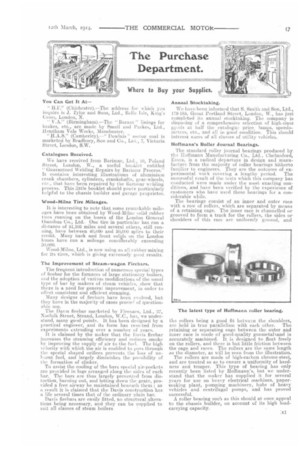The Purchase Department.
Page 23

If you've noticed an error in this article please click here to report it so we can fix it.
Where to Buy your Supplies.
You Can Get It At " HE." (Chichester).--The address for which you inquire is J. •Tylor and Sons, Ltd., Belle isle, King's Cross, London, N.
" V.A." (Birmingham).—The "Baram" linings for brakes, etc., are made by Small and Parkes, Ltd., liendham Vale Works, Manchester. "H.A.S." (Camberley).---" Dowlais" motor coal is marketed by Bradbury, Son and Co., Ltd., 7, Victoria Street, London, S.W.
Catalogues Received.
We have received from Barimar, Ltd., 10, Poland Street, London, W., a useful booklet entitled " Guaranteed Welding Repairs by Barimar Process." It contains interesting illustrations of aluminium crank chambers, cylinders, crankshafts, gear-wheels, etc., that have been repaired by the llarimar welding process. This little booklet should prove particularly helpful to the chassis builder and garage proprietor.
Wood-Milne Tire Mileages.
It is interesting to note that some remarkable mileages have been obtained by Wood-Milne solid rubber tires running on the buses of the London General Omnibus (Joe Ltd.. One tire in particular has run a distance of 51,105 miles and several others, still running? have between 40,000 and 50,000 roiles to their credit. Many back and front soys on the London buses have run a mileage considerably exceeding 30,000.
Wood-Milne, Ltd., is now using an all-rubber mixing foe its tiros, which is giving extremely good results.
The Improvement of Steam-wagon Firebars.
The frequent introduction of numerous special types of fireba•r for the furnaces of large stationary boilers, and the adoption of various modifications of the usual type or bar by makers of steam vehicles, show that there is a need for general improvement, in order to effect consistent and efficient eteaming.
Many designs of firebars have been evolved, hut they have in the majority of cases proved of questionable use.
The Davis firebar marketed by Fireoars, Ltd., :37, Norfolk Street, Strand, London, W.C., has, we understand, ninny good points. It has been designed by a practical engineer, and its form has reswted from experiments extending over a number of years.
it is claimed by the maker that the Davis firebar increases the steaming efficiency and reduces smoke by improving the supply of air to the fuel. The high velocity with which the air is enabled to pess through the special shaped orifices prevents the loss of noburnt fuel, and largely diminishes the possibility of the formation of clinker.
To assist the cooling of the bars special air-pockets are provided in lugs arranged along the sides of each bar. The bars are thus largely prevented from distortion, burning out, and letting down the grate, provided a free airway be maintained beneath them ; as a result it is claimed that the Davis construction has a life several times that of the ordinary plain bar.
Davis firebars are easily fitted, no structural alterations being necessary, and they can be supplied to suit all classes of steam boilers Annual Stocktaking.
We have been informed that S. Smith and Son, Ltd., 170-185, Great Portland Street, London, W., has just completed its annual stocktaking. The company is disposing f a comprehensive selection of high-class g9ads at half the catalogue price, lamps, speedometers, etc., and ail in good condition. This should interest users of all classes of utility vehielee.
Hoffmann's Roller Journal hearings.
The standard roller journal bearings produced by the Hoffmann. Manufacturing Co., Ltd., Chelmsford, Essex, is a radical departure in design and manufacture from the majority of x-oller bearings hitherto familiar to engineers. They are the outcome of ex
perimental work covering a lengthy period. The successful result of the tests which this company has conducted were made under the most exacting conditions, and have been verified by the experience of customers who have used these bearings for a considerable while.
The bearings consist. of an inner and outer race with a row of rollers, which are separated by means of a retaining cage. The inner race is channelled or grooved to form a track for the rollers, the sides orshoulders of this race are uniformly ground, and the rollers being a good fit between the shoulders, are held in true parallelism with each other. The retaining or separating cage between the outer and inner race is made of good-quality gunmetalkand is accurately machined. It is designed to float freely on the rollers, and there is but little friction between the cage and races. The rollers are the same length as the diameter, as will be seen from the illustration.
The rollers are made of high-carbon chrome-steel, and are treated so as to ensure a uniformity of hardness and temper. This type of bearing has only recently been listed by Hoffmann's, but we understand that the maker has supplied it for several years for use on heavy electrical machines, papermaking plant, pumping machinery, hubs of heavy vehicles and centrifugal pumps, and has proved successful.
A roller bearing such as this should at once appeal to the chassis builder, on account of its high load
carrying capacity. • •


























